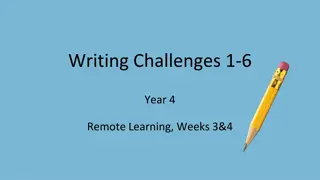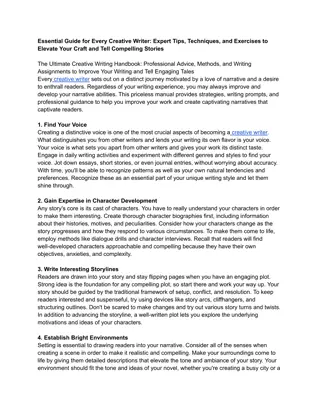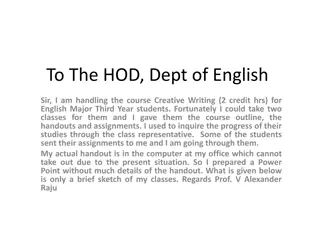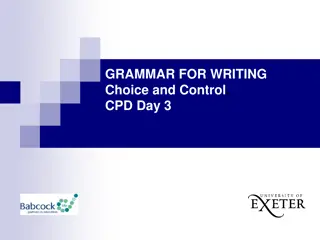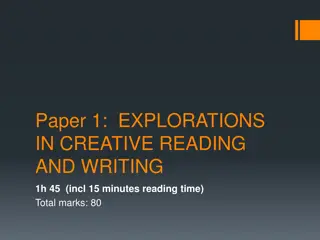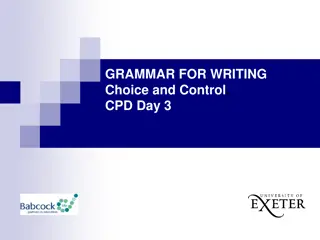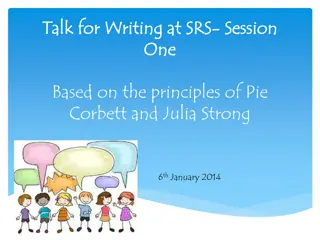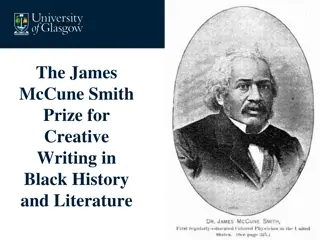
Crafting Compelling Stories: A Guide to Creative Writing Excellence
Uncover the secrets to crafting captivating narratives in this guide to creative writing. Explore common pitfalls to avoid, learn how to add depth to your characters and settings, and discover techniques to keep your readers engaged from start to finish. Get inspired by exemplars that showcase vivid storytelling and detailed character development, guiding you towards creating impactful narratives that resonate with your audience.
Download Presentation

Please find below an Image/Link to download the presentation.
The content on the website is provided AS IS for your information and personal use only. It may not be sold, licensed, or shared on other websites without obtaining consent from the author. If you encounter any issues during the download, it is possible that the publisher has removed the file from their server.
You are allowed to download the files provided on this website for personal or commercial use, subject to the condition that they are used lawfully. All files are the property of their respective owners.
The content on the website is provided AS IS for your information and personal use only. It may not be sold, licensed, or shared on other websites without obtaining consent from the author.
E N D
Presentation Transcript
So you have an idea But will it work for SQA submission?
Common Problems Premise takes too much world building/overly ambitious (Sci-fi and Fantasy) Premise is dull/hackneyed/clich (There s been a murder!... Mental health issues it s a dream world bleurgh!) There is no sense of a challenge or conflict to be overcome Lack of a clear protagonist No sense of where the story might move to next
So, now we write Start as close as you can to the problem you intend to have your protagonist face. Describe a feature of the setting that makes the story world come to life focus on adding detail to the small things and the larger world will be more interesting as a whole.
Exemplar The roar and hush of the sea skirts weightlessly, teasing the darkened edges of the dry sand whilst the other children's toes tentatively test the water. A flurry of splashes, all crudely painted nails and giggles, gleefully chase one another - their feet casting pebbles of pure white light into the air. To say that this childhood, their childhood, was abnormal would be wrong. Theirs was just as one should have expected. Their father looked on, vacant. Lost in worry over the seemingly important trivialities of his existence, he failed to see the change in young Amy's eyes - that hollow and malicious intent he often harboured towards himself. His head viced within the opinion pages of the slightly-less-right- wing-press, he had failed to read the meaning in her words over breakfast that morning. "I'm sorry, daddy," she'd pleaded, her voice a practised, fractured squeak. He hurriedly told her never to apologise. Not unless she truly meant it.
Start to add details to your protagonist Give them a reason for doing what they are doing. Try showing who they are through their actions rather than saying He was sad etc.
Exemplar The father, a skin-tight knuckle of a man, barely registered the panic apparent in the faces of those around him. The swell tide of men and mothers rushing into the sea jarred him out of inaction. In a slowly deliberate series of wrenching movements he rose to his feet, and in flashes of realisation, flurries of staccato steps, he became fierce elbows jostling for prominence at that open mouthed sea. Her body, held in sodden lumps, fell through the hands of the wailing clamour. The febrile wash claiming the father's breath, he paused, hand outstretched to touch Molly's limp neck.
Have your character try to overcome the problem It doesn t matter if they succeed or fail I care because of their attempt to do something. Make sure that whatever they do, it creates a secondary problem that you would go on to explore in Chapter 2 and beyond. BEFORE YOU WRITE, KNOW WHERE YOU WANT THE CHAPTER TO END.
Exemplar Amy refused to talk, even to her mother. A mute, bound by the memory of her indecision, it was impossible for her to comprehend her role in it all - other than her guilt at willing it to happen. She counted quickly in her head, from one to twenty and backwards again. She recited the nursery rhymes they sang, silently, listening for her sister's voice. She emptily played with the toys that had become hers. Her father was of little use in those following days. Every word he uttered was either of mumbled recognition or a passing, furious resentment. Her mother locked herself away, the crackling of cigarettes burning breaths to exhaustion the only evidence of her continued presence. Occasionally the fire lights of picture guns burst in flurries, clawing through the windows for an image to hang their story from. Amy clawed out the eyes of the little blonde dolly in her hands.



